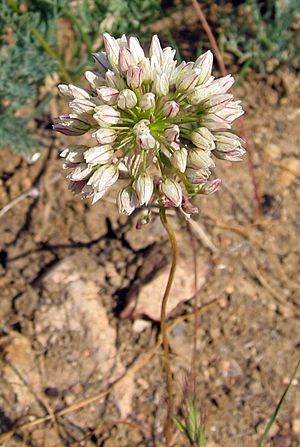Munz's onion facts for kids
Quick facts for kids Munz's onion |
|
|---|---|
 |
|
| Conservation status | |
| Scientific classification | |
| Synonyms | |
|
Allium fimbriatum var. munzii Ownbey & Aase ex Traub |
Allium munzii, also known as Munz's onion, is a very rare type of wild onion. It is a special plant found only in a small part of California. This unique onion is considered an endangered species, which means it is at risk of disappearing forever.
Contents
Where Does Munz's Onion Live?
Munz's onion is found only in western Riverside County, California. This means it is endemic to that specific area. It grows in the coastal sage scrub habitat, which includes local hills and mountains. You can find it at elevations between 400 and 900 meters (about 1,300 to 3,000 feet) above sea level.
Why Is Munz's Onion Endangered?
This special onion is known to grow in only about fifteen different locations. Its home is shrinking because of human activities. People are building new homes and cities, which is called urbanization. They are also turning land into farms, especially for citrus fruits. These changes destroy the natural places where Munz's onion lives.
Because it is so rare and its habitat is threatened, Munz's onion is listed as a federally endangered species. This means the United States government recognizes it needs special protection to survive.
What Does Munz's Onion Look Like?
Munz's onion grows from a small, reddish-brown bulb that is just over a centimeter (less than half an inch) long. This bulb is like a small underground storage unit for the plant.
Stem and Leaves
The plant sends up a straight stem that can grow up to about 35 centimeters (about 14 inches) tall. It usually has just one leaf, which is often a bit longer than the stem.
Flowers
At the top of the stem, you'll find a cluster of flowers called an umbel. This cluster can have up to 35 tiny flowers, each less than a centimeter long. The flowers have special petals, called tepals, that are white with a dark green line down the middle. As the flowers get older, their tepals turn red. The pollen and the parts that hold the pollen (anthers) are bright yellow.


